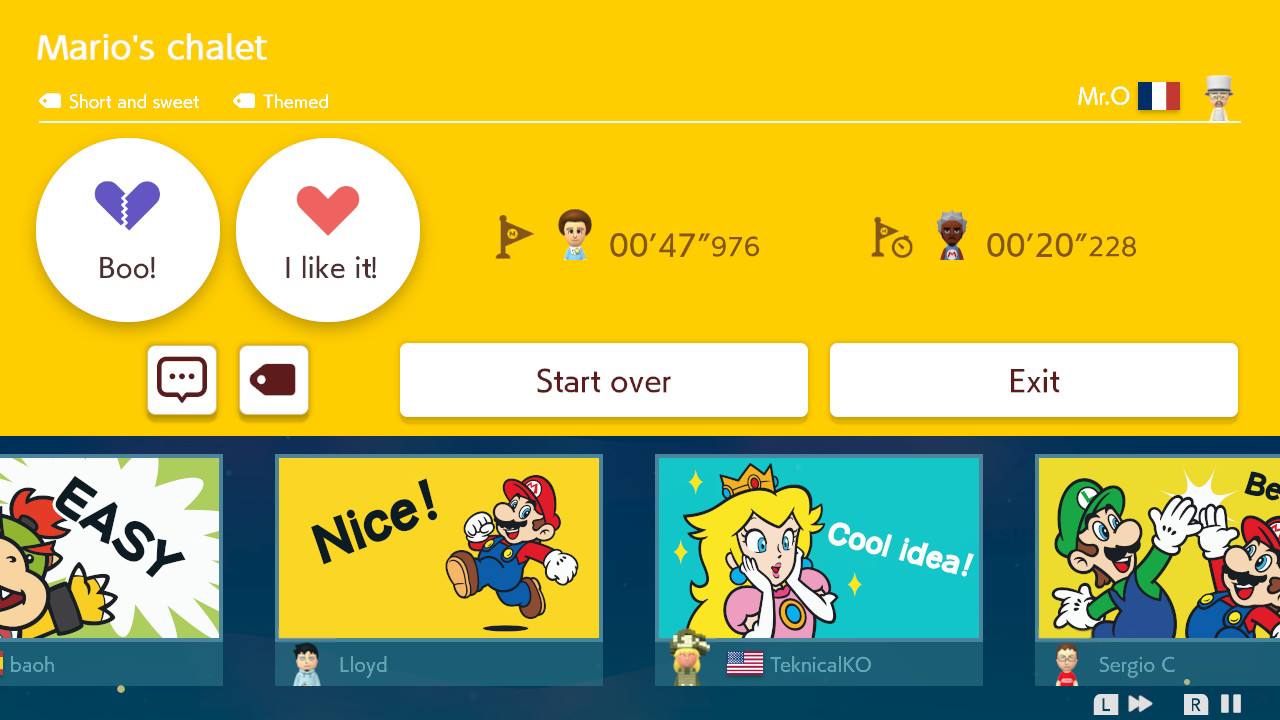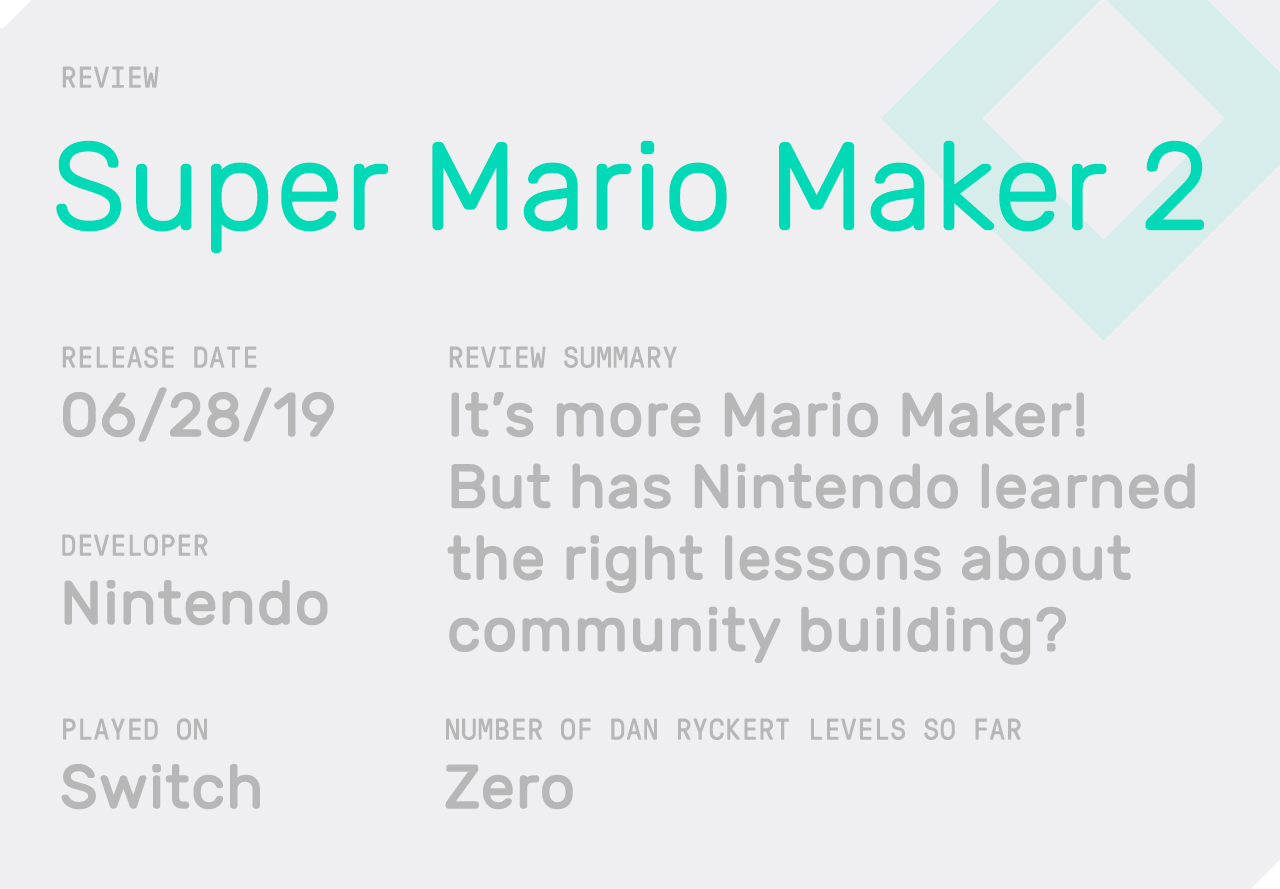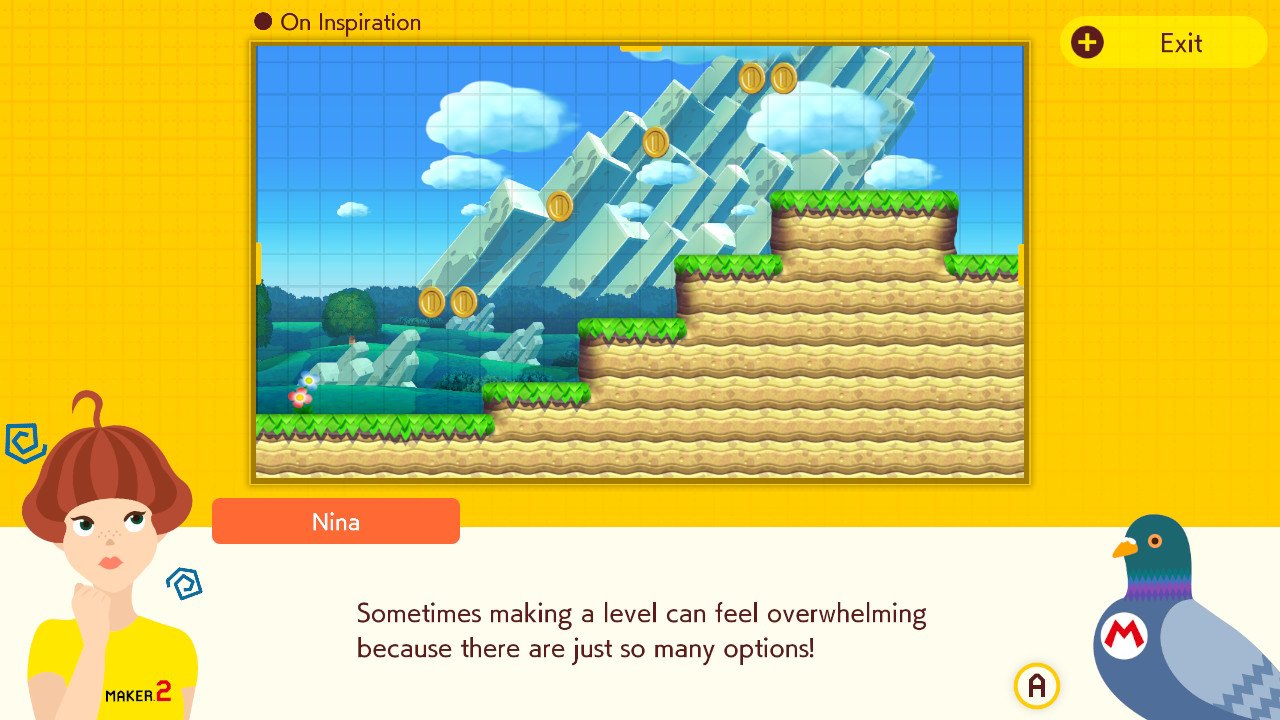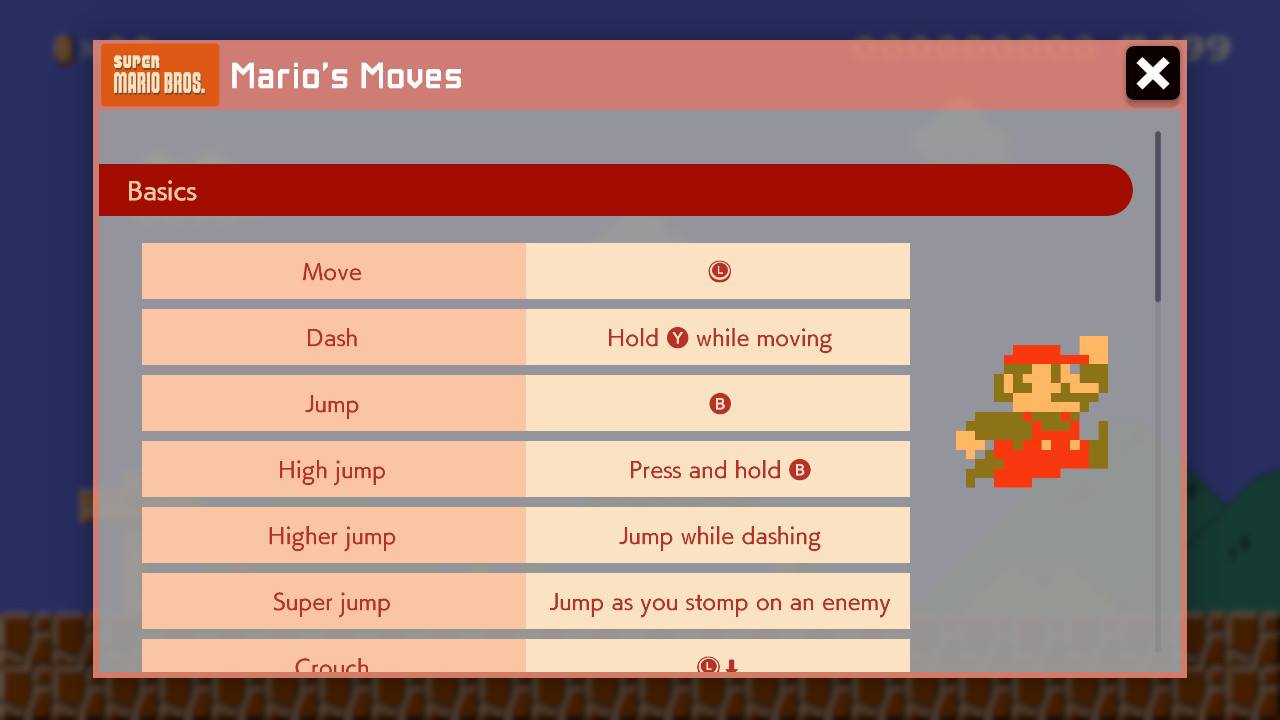‘Mario Maker 2’ Is Brilliant, But I Hope Nintendo Doesn’t Fail the Community
Credit to Author: Patrick Klepek| Date: Wed, 26 Jun 2019 14:39:49 +0000
There are a lot of ways to review a video game, but what do you do with a game like Super Mario Maker 2, whose potential is currently unknown? Nintendo doesn’t know what people will do with it, and I certainly don’t. What do you do about a game whose community, the beating heart of its future in the years to come, will be shaped by the way its developer responds, especially when said company is known to be opaque about the questionable and often frustrating reasons for its actions? That’s what will ultimately determine the game’s future, not whether they added cool tools (they did) or, finally, slopes (which they also did).
As someone that closely covered the Mario Maker community for years, who has been still writing features about the wild things those players are still up to only weeks ago, I cannot help but look at Mario Maker 2 through that lens, and spend more time wondering about the unknowable future, rather than walking through a checkbox of the game’s features. Of course that’s great—Mario Maker is one of gaming’s great achievements in the last 10 years.
I have a unique relationship with Super Mario Maker. For more than two years, several days a week—sometimes every day—I would spend an hour streaming the meanest levels the game would throw at me. Often, I won. Sometimes, I didn’t. I would yell, nearly toss my controller, and take a deep breath. One jump at a time, I’d make progress, and thousands went along that journey with me, cheering and jeering. What I didn’t do over those hundreds, if not thousands, of hours was make a level in Mario Maker. Not one. I never unlocked the full suite of tools in the level editor because I had no interest. I was a player, not a maker, and my specific attraction was levels that took hours to complete and pained my fingers.
Despite ignoring this part of the game, Mario Maker changed my life. Beyond developing bond with a specific set of platforming physics that was intimate in a way I didn’t realize was possible, it produced a bombastic rivalry with a colleague where a prominent WWE wrestler ended up shaving off my misbegotten facial hair after losing a bet, helped me accidentally raise more than $12,000 for charity, and created a legion of parents who’d make levels with their children before recording their adorable reactions when I’d later play their creations. (Those kids are why I never swore during my Mario Maker streams. After a while, I simply considered it a new layer of challenge to grapple with.)
None of this would have been possible until the game developed a community, and it’s way too early to have any idea what kind of community will develop around the game’s sequel.
As such, this put me in a bind when reviewing Mario Maker 2. What to make of a game whose pitch is an evolved set of creation tools I want nothing to do with? The addition of slopes, whose absence from the original game was so glaring it became a meme in the community, pleases me… conceptually? But for me—a player who never makes his own levels—the ability to drop a slope onto the screen means nothing without the action of someone else—a creator with a vision—transforming potential into something more. That hasn’t happened yet; largely, the only people creating in Mario Maker 2 right now are game critics.
Here’s my review of their stages: They’re (mostly) bad!
The more I thought about it, however, the question of what one means by a “bad” is at the heart of the other changes Nintendo’s made. I realize you might not have expected to walk into several thousand words about the seemingly small interface changes made for Mario Maker 2, but as someone who’s talked to the people who build the levels you play yourself and watch others work through, it’s these changes that will have the greatest longterm impact on Mario Maker 2, and where Nintendo’s historically had very mixed success.
Here’s one example, that seems small but has big implications. When you finish a stage, you now have the option to do more than give it a generic like, you can either give it a heart (“I like it”) or a broken heart (“Boo!) before leaving a Miiverse-like comment or suggesting an alternative tag to describe the stage. The first Mario Maker didn’t have a way to give a thumbs down for the same reason lots of social networks only include approval metrics: The mere presence of the potential for negative feedback is likely to invite more of it, and in this case, it’s a brute force solution and without meaningful ways to express one’s emotions.

Take the stages I tend to bash my head against. They’re deliberately hard, weird, and subversive, often taking more inspiration from the world of kaizo—stages that push back on what’s normally considered proper level design, and are typically punishing— than anything Nintendo’s cooked up over the years. If you don’t like those stages (and I don’t blame you for a second), you might be tempted to hit that stage with a “Boo!” Who’s that helping, though? Not hitting “I like it” is itself a dislike, but one that doesn’t explicitly punish the creator for making something you didn’t want in the first place. Weirder, the amount of dislikes a level gets doesn’t show up anywhere—you can’t even look up how many dislikes your own levels have garnered. Does it simply influence the algorithm? So, why bother pressing it at all?
Whatever it actually does, making the “Boo!” prominent underscores Nintendo’s confusion.
The wiggle room Nintendo tries to give itself is through tags, short and pithy descriptors to indicate the tone of a stage. The first Mario Maker had 15 tags: automatic, music, puzzle, gimmick, dash, remix, thumbnail, costume, yoshi, theme, speedrun, autoscroll, shoot ‘em up, track, traditional. Mario Maker 2, weirdly, has only nine: standard, puzzle-solving, speedrun, autoscroll, auto-Mario, short and sweet, multiplayer versus, themed, music. Somehow, Nintendo actually went backwards with Mario Maker 2. What does “standard” mean? And what tag should be used to convey “this is hard as hell, stay away and please don’t boo it”?
Mario Maker 2 desperately needs to give creators more detailed descriptors, for the benefit of people who do and do want to seek out specific types of levels. In an ideal world, tags would be crowd-sourced and Nintendo would surface the most popular ones, but this seems unlikely. Hopefully, though, the company will add to the pile. As proposed in this reddit thread discussing the game, descriptors like “sneaky” or “devious” would go a long way in helping creators better explain their work and let players make sure they’re finding what they enjoy.
But this tension between what the world does with Mario Maker and how Nintendo portrays Mario Maker has always existed, and it’s not exclusively about streamers playing hard levels.

Slowly but surely Nintendo has tried to chip away at the popular notion the company doesn’t understand the Internet, but over the course of covering world around Mario Maker, it became clear that there’s a difference between running competent multiplayer servers and cultivating a community, and it often felt like Nintendo was uncomfortable with parts of Mario Maker’s success, and it lead them to undermine the very people keeping the game alive years after release.
For example, Nintendo would regularly purge “low popularity” levels from the servers, a fuzzy metric that lead to Mario Maker fans begging one another to play their levels, hoping to survive the next wave of deletions. I actually had the father of a seven-year-old kid reach out to me, hoping I would play his level on stream and save it from Nintendo’s crappy policies. When I relayed this story on a stream, my viewers rallied around Daniel and played it a bunch of times. As a result of this, Daniel’s stage, Piranhas on the Loose, is still available, but the takeaway is clear: tons of levels, lots of bad ones made by kids who did not understand what is happening, were having their levels routinely deleted by Nintendo. Bad!
You can still play a level locally, obviously, but that’s not the same. The appeal of Mario Maker is the ability to share your creations with the world and have other people play it. Not every level takes off immediately; some randomly become a phenomenon months later.
Mario Maker levels also had a discoverability problem for a while because: A) The Wii U couldn’t capture video without external hardware (not a problem on Switch) and B) There was no easy way to share levels with people, akin to a browser link. Nintendo solved that with its extremely useful “bookmark” website, but the company hasn’t said anything about its plans for Mario Maker 2. The bookmarking website hasn’t been updated, and while the ideal backup solution would be searching/sharing stages via Nintendo’s official Switch app, there is no indication such a feature will be there at launch. That’s unacceptable in 2019, but also unsurprising? Super Smash Bros. Ultimate didn’t get that feature for several months, either.
And look, there’s good reason for Nintendo to delete some levels, especially ones using outside hacking to cheat or featuring inappropriate material for a game aimed at all ages, but Nintendo’s inability to develop clear policies to explain itself has been hugely frustrating. It’s how one of Mario Maker’s most prominent streamers, GrandPoobear, had all his levels erased for reasons unknown. Maybe because of the word poo? Maybe because his stages were often influenced by kaizo design, which can skirt the line between glitch and exploit?
It’s also why a ton of creators were pulling their hair out when Nintendo secretly changed the hit box around P-Switches, the object that can swap blocks into coins and vice versa. Expert players can also use the P-switch as a platform with some tricky timing, but for reasons unknown, Nintendo decided to make using the P-Switch as a platform significantly harder in a random patch—without announcing the change. Worse still, the game doesn’t differentiate between levels designed pre-patch or post-patch, so when you load a stage requiring the P-Switch to be used as a platform, there’s no way to know which level of timing is needed.
In Mario Maker 2 itself, Nintendo says it will delete courses if “the user intrusively requested likes from other users in-game,” “the user took advantage of bugs that were unintended by either the course creator or the developers,” “course data was modified in an unintended way,” “the user frequently disconnected during play,” and “any other behavior in violation of the Nintendo Code of Conduct.” A lot of those are reasonable and meant to create a level playing field, but they’re only as reasonable as the actual justification used to enforce them.
There’s no way to know if Mario Maker 2 will be any different in that regard because it has everything to do with Nintendo’s reactions to the community, and not the software’s coding.
The thing is, even if nothing changes, even if Nintendo continued to frustrate in the way Nintendo often frustrates, Mario Maker 2 is destined to flourish because it’s building on an incredible foundation. It’s more Mario Maker. They didn’t screw that up. The original game already got the hardest part right, making a naturally intuitive creation suite with a button to upload the level to the Internet in seconds. It’s easy to forget what a remarkable accomplishment that was. Mario Maker 2 isn’t a reinvention because one wasn’t needed.
I did break a certain streak with Mario Maker 2: I actually made a level (2HW-5V2-LFG). True to form, it was incredibly easy, to the point that building “Jump, Man” took less time than proving to Nintendo I could beat it, allowing it to upload. With Mario Maker 2, Nintendo has included a bunch of useful tutorials and built-in guides to walk you through everything from the basics—establishing a workflow, deleting objects—to more advanced concepts—”using walls to control players”—and even existential questions, like how to find creative inspiration.
(Note: I don’t think level codes I’m listing here will work when the game launches; Nintendo’s indicated the servers will be flushed. I’ll update the codes if the levels are later re-created.)

Also, I wish it was possible to zoom out and edit; right now, if you zoom out, you can only delete and move objects. It makes it hard, at least as a newbie, to conceptualize the stage design.
Mario Maker 2 does add a largely superfluous “story” mode with a bunch of short but clever levels and an eye-raising amount of references to abusive management practices by Toadette, but outside of growing your familiarity with the game’s new tools and gizmos, you’ll graduate past this fast. Do not mistake this for a proper single-player Mario game stuffed into Mario Maker 2 because this definitely ain’t it. I’m glad it’s here and it served as a good way to reacquaint myself with the subtle but notable ways different Mario games feel, especially the new 2D take on Super Mario 3D World, but the wait for Super Mario Odyssey 2 continues.
Another really welcomed addition to Mario Maker 2 is the ability to pause and pull up a detailed sheet of moves for whatever “version” of Mario you’re playing. I doubt this will ever help me fully come to grips with cape flying in Super Mario World, but that’s out of Nintendo’s hands.

Deepest apologies for my level “Jump, Man,” by the way. I came up with the concept—a pit of despair with the new hook gizmo in-between—while cooking breakfast for my daughter, and ended up with something that, initially, felt unbeatable. It was only after some goofing around that I developed a technique for surviving the chasm (and the sun that’s chasing you the whole time), and spent the better part of an hour perfecting my way across. Good luck?
I’ll admit that having a taste of what it’s like to make a devilish contraption for the public and watching them eat shit makes me reconsider my previous stance of only playing levels. When Mario Maker 2 notified me that Kotaku features editor Chris Kohler, one of my Nintendo Switch friends, had played the level, I checked the level’s stats and noticed he’d only played once, immediately died, and moved on. When I called him out on this fact, he responded with “patrick design a real level.” I’ve never been motivated to make nightmares.
Another reason I struggled with my thoughts on Mario Maker 2 was specifically because the kinds of stages I enjoy aren’t there yet. Most of what’s online during this weird period before the public gets access is stuff that’s made by whoever Nintendo’s entrusted with early copies (as of this writing, one of the more popular Mario Maker 2 streamers I talked to didn’t have the game yet) and game critics. That’s a formula for basic levels experimenting with the new features, like being able to pilot a car, but unlikely to result with the finger breakers I desire.
(Even though I “disliked” most of these levels, I did not assign them a “Boo.”)
In my despair, I found some gems, like “スピウン〜梅雨入り〜” (BKS-NGL-VMG) by Japanese creator ばり. Classified as “puzzle-solving” and “speedrun,” those are not inaccurate terms—you do need to move fast and solve puzzles—but it does not do enough to compliment the trickery at work here, like the section where the player needs to bounce between two spots while a shell knocks and off/on switch back and forth, as you wait for a moving platform to crawl in your direction—all while carrying a POW block that you need to use as a platform to enter the next door. It’s a great use of a fun new tool in the game, and demonstrates what some creators are going to do with these new options at their disposal.
These levels are not for everyone—most people, even. But what I’ve come to appreciate in this take on Mario is being asked to string together a series of complicated moves in a row, moves understood through careful play and internalization of how Mario glides through the air, until encountering the next roadblock. Sure, I’m likely to die at that next roadblock, requiring me to string together those same moves that I know how to do but are bored of doing at this point—which means I’m gonna screw ‘em up. It’s equivalent to getting killed by a regular enemy while doing a run to the boss in Souls. I’m better than this, but the raw excitement of trying to piece together the next part of the puzzle gets the best of me. It’s a draining process, but one whose reward loop fuels the next obstacle. If I did this one, you can do the next one. Then, finally, it comes together and the level is over. Next!
This rush of exhausted success earned by repetitive work is epitomized by this one particularly dastardly jump from Trollverse (2W7-BTH-7MF) by Spanish creator AliasNextN:
There’s a million ways to screw this jump up. If you touch a music note, you’re locked in this spike-filled death box. If you try to enter as big Mario, thinking the extra life will give you a chance to take advantage of the brief invulnerability granted by being hit, you’ll discover this also means you’re trapped. If you hold the jump button too long, he’ll jump too high. If you don’t hold the jump button long enough, he’ll touch a music note. You need to be running at full speed and tap jump at precisely the right time and with precisely the right length of touch.
The first time I successfully made the jump, I let out an audible scream. And that was before I made it to the next screen and started to realize what the level was asking me to do next:
Goddamnit. (If it’s not clear from the video, the only way to proceed is by carefully/randomly lining up the endlessly spawning fire power-ups, using the spike turtles to turn yourself into small Mario, then sneak past this section without getting touching any of the power-ups left over. It’s maddening.)
These moments are what I live for in Mario Maker, and why my concerns about how the game is thinking about its community gives me pause. Without a robust and well-supported community, Mario Maker is nothing. In recent years, Nintendo has gotten better about listening to what its fans have asked for, like the ability to play as a person of color in an Animal Crossing game. But that’s not always true, and it often feels like the company has to be dragged in that direction with great reluctance. Nintendo is a company that craves control, and what makes Mario Maker so different from its other creations is how much control is put in the hands of players. That also means they need to trust those players. I hope they do.
Follow Patrick on Twitter. If you’ve noticed anything interesting happening in Mario Maker, reach out at patrick.klepek@vice.com. He’s also available privately on Signal. Mario Maker Mornings will return.
Have thoughts? Swing by the Waypoint forums to share them!
This article originally appeared on VICE US.